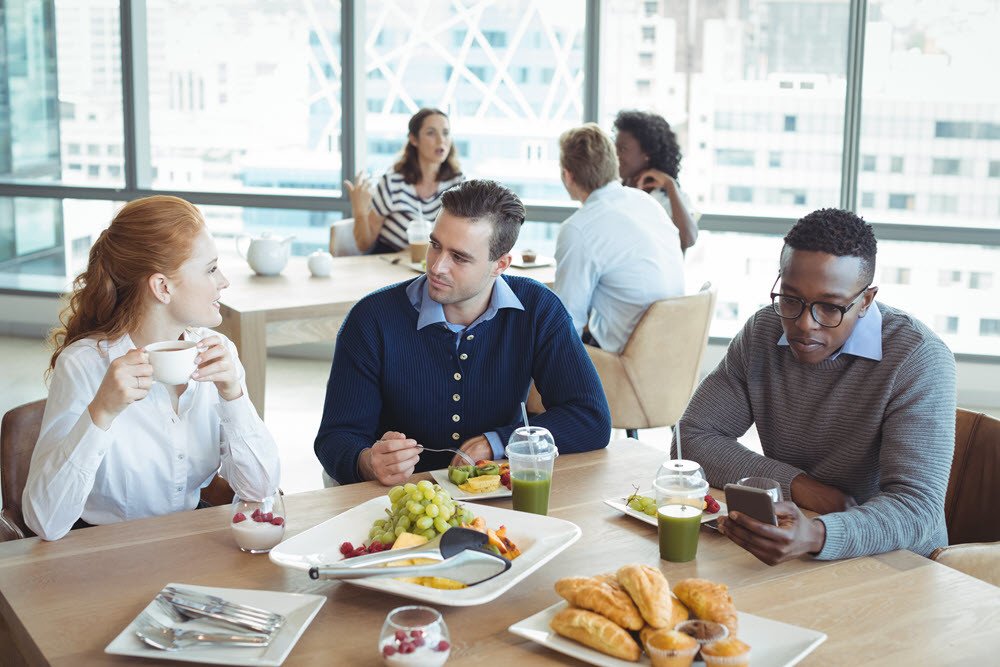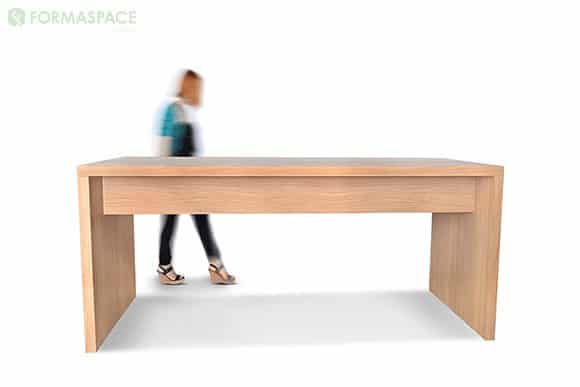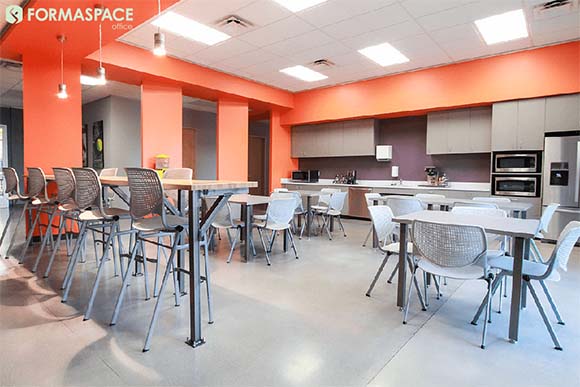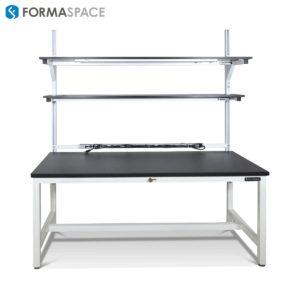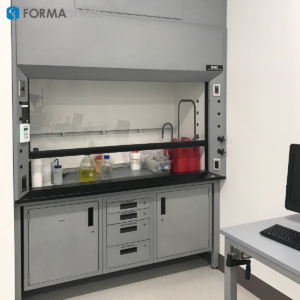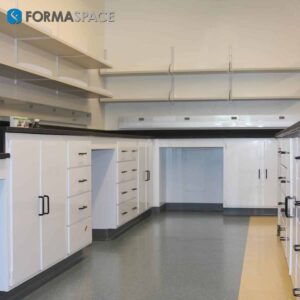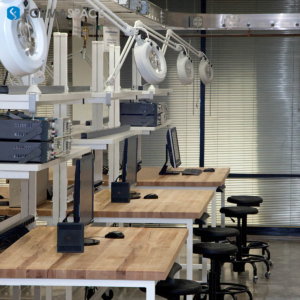As a company manager or business owner, you’re constantly challenged to find ways to lead your organization to “work smarter, not harder.” This week we take a look at why leading-edge companies, like Google, Twitter, and Spotify, have introduced dedicated spaces to increase social interaction at work — ranging from modern reincarnations of traditional office cafeterias to active office lounge spaces kitted out with custom break room furniture — all designed to encourage employees to take physical and mental breaks away from their desks throughout the work day. The net result? Increased productivity and higher worker satisfaction.
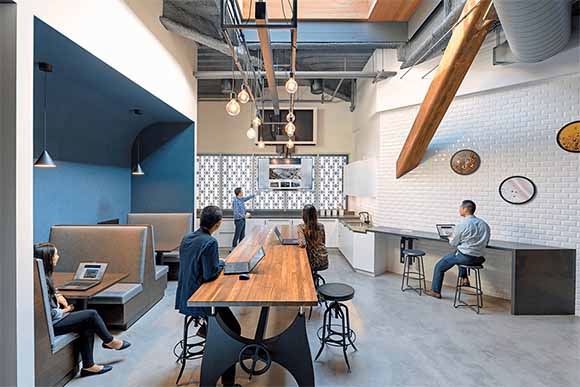
Lunchtime habits at work are often uniquely tied to culture. As Americans, we take great pride in our work ethic, and often make broad statements comparing ourselves favorably to Europeans, particularly the French, with their stereotypical hours-long lunches conducted over a bottle of wine, or “shut down the office for two or more hours” siestas that reputedly take place each afternoon in Spain.
Culture shock works in reverse too. Here’s a good example: business visitors from Germany — the European economic powerhouse that is often conveniently overlooked when Americans make productivity comparisons — suffer intense culture shock when visiting American workplaces. Why? Whereas most German employees sit down to eat in office cafeterias each and every day – precisely at noon, it being Germany after all – few Americans do the same.
According to reporting in Germany’s leading news magazine, Der Spiegel, surveys show that upwards of 60% of American workers eat lunch at their desks on any given day.
Yes, long gone are the “Mad Men” two-martini executive lunches we once enjoyed during the 1950s and 1960s, having largely been replaced by the solitary habit of eating lunch at our desks while working (sandwich in one hand and a computer mouse in the other.)
Why is this? According to the SHRM 2014 Employee Benefits Report (behind a paywall), less than one in five American employers provide an office cafeteria where employees can sit down to a meal, and less than 15% of employers offer subsidized employee meals.
For many observers (from overseas and here at home), this utterly dismal staple of American workplace culture — eating at our desks, ostensibly in the name of saving valuable time — is best summed up by the savage Internet “Sad Desk Lunch” meme.

Rediscovering the Productivity Benefits of Employee Office Cafeterias and Office Lounges
That trend is starting to change.
The reintroduction of office cafeterias and enhanced office lounges (aka break rooms) to the American workplace is part of an ongoing major overhaul in modern office design — a movement characterized by incorporating large, open spaces, shared communal workspaces and striking visual elements (often based on a strong, industrial-look aesthetic.)
TIP: If you are new to the benefits of this type of office design, you’ll want to read our article on How Industrial Office Design Supports Your Brand.
As evidence of this trend of (re)incorporating cafeteria and lounge spaces into modern office designs, we can point to four recent Formaspace projects:
At GE Ventures, Formaspace built their custom employee cafeteria and lounge tables.
At Twitter, Formaspace built their custom employee cafeteria table and desks.
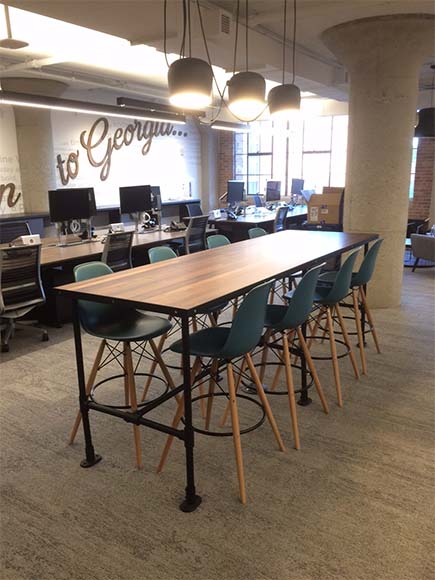
For this unnamed client, Formaspace built custom break room furniture with tables that have a unique hand-crank mechanism to change the height from a seated to a standing position.

At the Busch manufacturing plant in Austin, Texas, Formaspace designed and built this custom break room furniture for their new employee office lounge and kitchen canteen.
Before you dismiss this trend as something limited to high-flying West Coast tech companies, take a look at what’s happening in Middle America. In the Chattanooga metro area, Blue Cross Blue Shield of Tennessee has built a stunning glass-walled “Hill Top Cafe” where employees can look out at the Tennessee River as it winds past Lookout and Signal Mountains. Volkswagen’s Chattanooga car assembly factory has a new “Das Cafe” featuring outdoor seating and umbrellas, and, over the state line in Georgia, Shaw Industries completely updated their old cafeteria to make it look and feel like a modern Starbucks coffee shop.
Four Ways Office Cafeterias and Office Lounges Can Improve Employee Satisfaction and Productivity
It’s time to get specific.
Just what productivity benefits can an employer expect to get by investing in new corporate cafeterias, break rooms or office lounges?
1. Keeping Employees “On Campus” Reduces Time Spent Traveling Away for Food and Reduces Risk to Trade Secrets
As the Wall Street Journal writes, many of the largest US tech companies are now making major investments in their company campuses, equipping them with amenities like corporate cafeterias, break rooms and gyms – all designed to keep employees happy and engaged without the need to ever leave the office.
Keeping employees on campus reduces the time spent traveling away from the office for lunch, where the lunch hour can often expand to 90 minutes or more.
As it turns out, the IRS agrees. According to IRS Code Section 119’s “Convenience of the Employer” Test*, the benefits of an employee cafeteria can get tax-exempt treatment if the employer wants to ensure shorter meal periods, say 45 minutes.
Security can be another concern as well. When employees travel out to lunch, what do they talk about? Work of course. If your company has closely held trade secrets, loose talk at area restaurants could make your employees an easy mark for opportunistic industrial spies.
*The other relevant IRS regulation to look at is Code Section 132: De Minimis Exclusion for Subsidized Company Cafeterias. In brief, if the cafeteria operation breaks even (by charging employees a nominal amount for food) then employee meals are excludable from taxable employee income.
2. Don’t Forget That “Sitting is the New Smoking”: Trips to the Office Cafeteria and Office Lounge Get Employees Up and Moving
Healthcare costs and lost productivity due to illness and injury are major concerns for all companies today.
As we’ve written about before, there is increased concern about the health risks when we sit for long hours at a time each day at our desks. (See our article on Sitting is the New Smoking.)
That’s why we not only recommend providing each employee with a powered Formaspace Sit-Stand desk (which can be raised and lowered throughout the day), we also believe it’s important to encourage employees to take regular breaks to get the blood flowing, such as walking to the company cafeteria for lunch or to the office lounge several times a day.
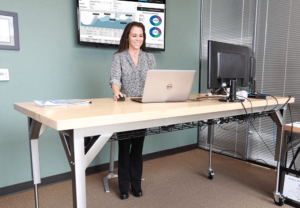
As an employer who operates an office cafeteria, you will also have more opportunities to influence the overall wellness culture among your staff by promoting healthier food and beverage choices.
According to a study by Willis Towers Watson in their 2016 Best Practices in Health Care Employer Survey, poor cafeteria options can undercut the very wellness programs that employers want to promote. Suggestions for improving wellness in the report include revamping menus, displaying caloric content, providing healthy cooking demonstrations as well as partnering with local farmers markets or community-supported agriculture (CSA) groups to provide employees with healthier food and beverage choices.
Of course, when all else fails, consider doing what Google reportedly does: hide the fattening snacks and sugary beverage choices away in the upper cabinets.
3. Office Cafeterias and Break Rooms are Critical Social Interaction Hotspots
In a world where technology allows employees to work from anywhere — at home or the coffee shop or the office — employers are looking for ways to bring the focus back to the office.
Why is this important? Employers need to encourage those moments of serendipity and collaboration, where employees come together to exchange fresh ideas and come up with innovative solutions to solve tough problems.
If you’ve been keeping up with our articles on office design trends, you’ll recall that Susan Cain, starting with her book Quiet Revolution: The Power of Introverts, has championed the need for quiet spaces in the workplace for thoughtful, contemplative thinking.
We can think of office cafeterias and lounges as the noisy Yin to Cain’s “quiet space” Yang. Public spaces in the office, like cafeterias and lounges, encourage animated conversation, even blowing off steam, by providing a space that’s fit for this purpose.
4. Don’t Overlook the Importance of High Profile Amenities for Retention and Recruiting Programs
As the core offerings from many companies increasingly shift toward Internet-based products and services, the quest to recruit and retain the best-and-brightest knowledge workers is on the mind of every corporate CEO in America – or should be!
This major tech shift also comes at a time when the oldest of the Baby Boom generation is retiring in large numbers, often to be replaced much younger, Internet-savvy Millennial and Gen-Y workers.
As you’ve probably discovered, these younger workers often have many different expectations about what the idea workplace should look like (hint: make it look like a cool coffee shop); how work should be organized (hint: conduct project work in teams); what they should eat (hint: sustainable healthy food choices, often vegan); and where to work (hint: take the laptop to the office lounge).
Executives and office managers who find the choices of these younger workers baffling and unreasonable do so at their peril, because not only are they now the largest generation of people (in the world, as it turns out), they also offer the potential skills and talent that your company will need to succeed into the future.
Many of these highly desirable workers will be influenced by what they see when they tour your facility. The quality and design of the interiors as well as amenities, such as “cool” office cafeterias and office lounges equipped with “cool” break room furniture, can not only help you recruit specific candidates, they can have a knock-on effect as these candidates talk to their friends and contacts on social media about what a cool place company X is to work (or, on the flipside, how dreary a place it would be to work at company Y.)
To learn more about how the right look in office design can help support your brand, read our article.

Interested to Know More About How to Create Attractive Office Cafeterias, Lounges and Break Rooms?
If you knew there was an American company based in Austin, Texas that makes custom, build-to-order furniture to order for well-respected, leading-edge companies like Twitter, Busch, GE Ventures and more, wouldn’t you want to talk to them?
Of course, you would. And you’re in luck because we want to talk to you too.
Drop us a line by filling out the quick contact form below, and we’ll have an actual live person, one of our Formaspace Design Consultants, contact you right away.
We can help you create the office environment you’ve been waiting for. Contact us today.


